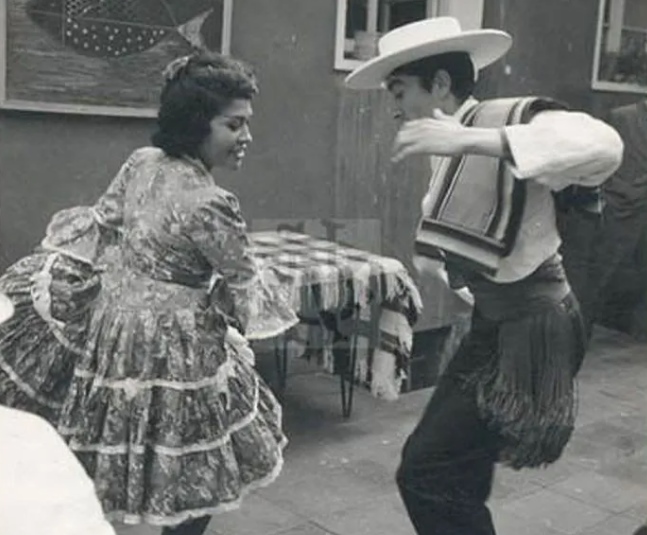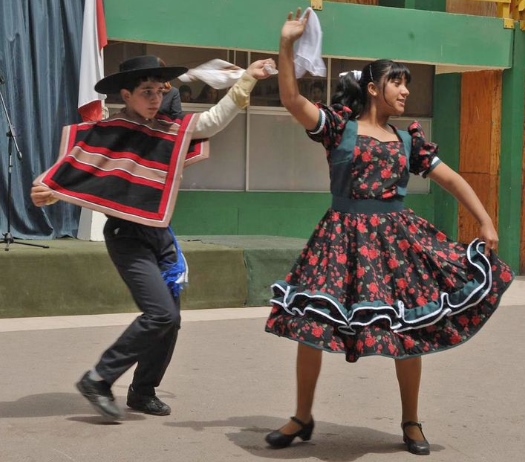The Cueca dance, also known as La Cueca, is recognized as Chile’s national dance.
It originally represents courtship between a couple but is also closely associated with the history of this country, especially the political events throughout the 20th century.
It’s about time for us – dance lovers, to take a seat back and intrigue ourselves with the interesting stories and facts about the Cueca.
Table of Contents
Cueca Dance Origin
Cueca is one of the dances whose origins I don’t know for sure. However, the majority of experts believe it is very likely to originate from Europe, with Spanish auras and perhaps influences from the indigenous.
In detail, they speculate it to be closely related to the Zamacueca dance, which harbored many similarities with the Fandango dance of Spain and became well-known in Peru during ancient colonial times.
Soon enough, Zamacueca found its way into Chile and adopted a shorter version of the name. Sometimes, people also refer to La Cueca as La Chilena (“The Chilean”).
When the Pacific War ended, because of the hostility directed at Chile and the honor of Peru’s combatants, La Chilena was changed to Marinera. Therefore, both of them are often connected to the Zamacueca roots.
A less popular theory indicated that La Cueca was created in South America in the 19th century as a dance for a duo, inspired by how a rooster and a hen behave in their ritual of courtship.
It explains why we often see the male dancer portray an eager attitude while the female is more demure and elusive. The ending tends to feature the man on his knee, on which the woman victoriously rests her foot.
Cueca dance in Chile’s history
The records point out that the Chilean Cueca appeared in parties and taverns around the 19th century. The experts describe it as highly structured regarding all aspects such as music, lyrics, and dance.
In the history of Chile, La Cueca has a rather prominent role. The fact that the working class contributed so much to the dance’s development only granted it more access to daily life.
After a long day of working hard, dancing to Cueca with your beloved is such a great way to destress.
However, when the dictator Augusto Pinochet announced La Cueca as the national dance of Chile, it was distorted into the symbol of suppression and oppression, no longer recreation and freedom.
With the promotion of Pinochet’s government, there was no doubt that the Cueca dance was more practiced and known all over Chile than it ever was.
But the relaxing and fun nature was stolen, for people had to learn the dance on demand and could only perform in official events organized and permitted by the government.
Opposition against the government usually ended up with the disappearance of those who dared to be loud in their disagreement. The dictatorship, with endless civil wars, practically tore the country apart and left many families with trauma.
Who would have thought the ones who used the dictator’s tactics against them would be victims of their oppressive ways?
Violeta Zuñiga, an activist for human rights, came up with La Cueca Sola (meaning The Lonely Cueca) after the government took her husband. Since the dance was meant for a duo, her solo performance was both astonishing and heartbreaking.
Deeply synchronized with her emotions, more and more women in the same situation joined Violeta and eventually created a huge wave of protests.
Even after the dark era was over, the impact and consequences it had on the cultural and social aspects of La Cueca was still present. Nevertheless, Chile healed as a nation and the people slowly learned to embrace the Cueca dance as part of their history and tradition.
Check more: Kochari Dance: Origin, Performance, Steps, Variations & More
Cueca Dance Costumes
As the Cueca was promoted to be Chile’s national dance, the most appropriate outfit for a formal performance is traditional Chilean clothes.
The male dancers will adorn flannel ponchos over shirts and riding pants. Their accessories include huaso hats, riding boots with spurs, and jackets.
Meanwhile, the women have fewer accessories but the dresses they wear are always very eye-catching.
The common colors for Cueca vary from white and blue to red and black. In most cases, the entire dance troupe will want to wear the same primary color for the sense of a theme.
Cueca Dance Steps
The Cueca dance traditionally means the courtship between a couple, hence it can be performed as a group but the dancers will be paired up accordingly.
The next question for us is: How to do the Cueca dance?
The man will be the one starting the dance by approaching his partner and offering his arm, and they will escort each other around the stage and circle the partner. This part is often known as the “cuarteta”.
The main part, called “seguirilla” of the performance, starts when they come to a destined spot, face each other, and pull out their handkerchief.
With the handkerchief high in the air, they dance as the man moves around the woman. The dancers can move closer or away from each other, but they never touch.
The last section, “remate”, features the man asking for the woman’s hand and the duo finishing the performance hand-in-hand.
Cueca Dance Music
The oldest music associated with Chile’s La Cueca is credited to the people of Mapuche, who use percussion instruments and wooden flutes in religious practices.
With the arrival of Spaniards, they adopted guitars and harps, which are still part of Chile’s modern music.
In a traditional Cueca dance, you will find percussion, guitar, and accordion, and the rhythm can alternate between ¾ and 6/8. The harmonic sequence in use is simple and the structure typically includes three parts.
Depending on the region and the purpose, other instruments might also be included. During ceremonies, you are likely to spot trumpets or tubas. Some Cueca forms even focus on the lyrics of the song played.
Cueca Dance Variations Nowadays
Today, La Cueca is still present in various forms. Depending on where you are or what style you want to learn, the Cueca dance you have access to might be a bit different from the Chilean version.
For example, the north and west of Argentina quite favor La Cueca, and each province has developed unique traits in its variation.
In Bolivia, they have Cueca Paceña, Cueca Chuquisaqueña, Cueca Tarijeña, Cueca Cochabambina, and more in different regions.
The rhythm remains the same most of the time, but the pace and the outfit make each style distinctive from another; some styles are lively, the others are elegant.
Final Words
The Cueca dance, or La Cueca, is a living witness of the eventful and unsettling era that Chile went through, hence its connection to the country’s history and culture is undeniable and indispensable.
Furthermore, Cueca’s influence reaches beyond the country’s territory and spreads to neighboring countries with various versions, which ensure its vitality for many years to come.


